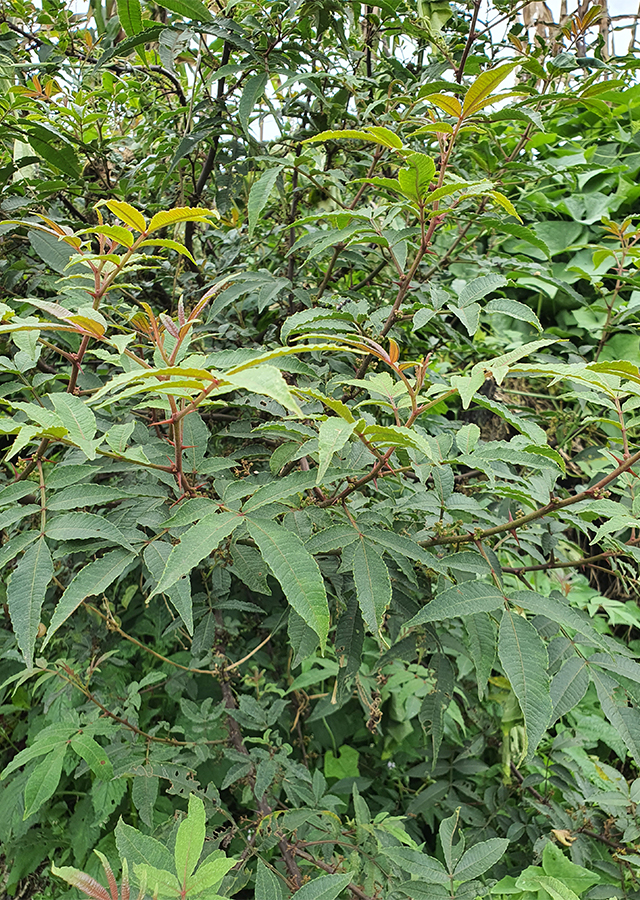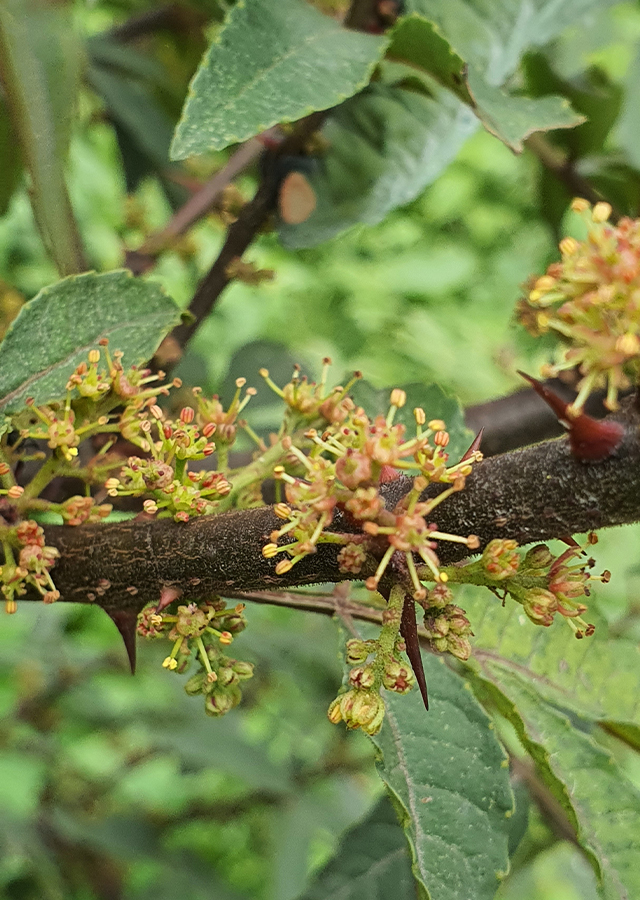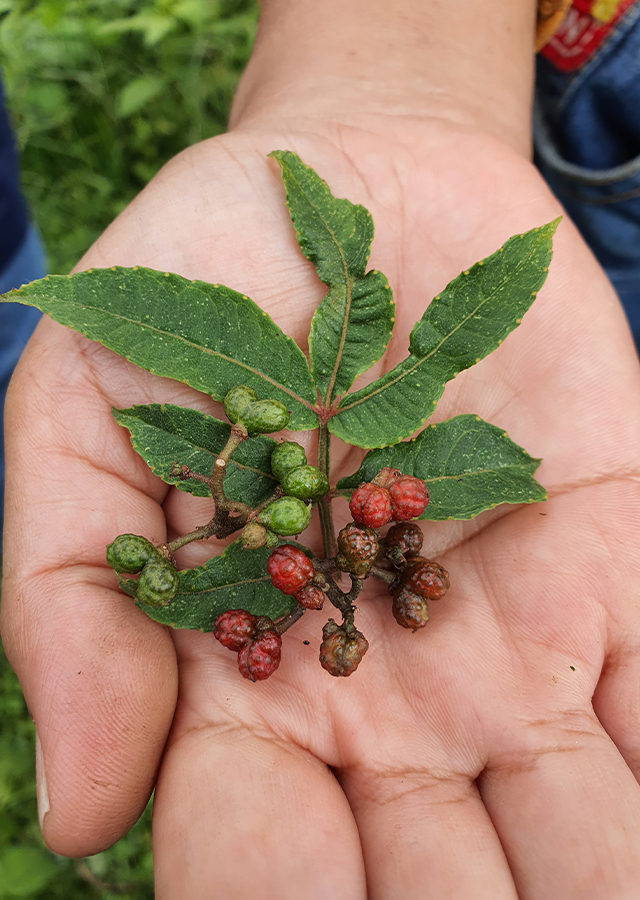Traditional Herbs from Zanthoxylum acanthopodium
fever
- Prepare the bark of the andaliman stem, wash it thoroughly.
- Boil the skin until it boils.
- Let it warm.
- Strain and drink.
overcome_the_wind
- Prepare the fruit\u00a0andaliman wash until clean.
- Chew directly to warm the body and overcome colds.
What is Zanthoxylum acanthopodium Looks like??



Parts of Zanthoxylum acanthopodium that could be used
- Seed
- Bark
- Fruit
- Root
Zanthoxylum acanthopodium Distribution
Andaliman or Zanthoxylum acanthopodium is a plant that spreads naturally in South Asia, China, Tibet, Indo-China and Indonesia. The distribution of andaliman in Indonesia is only in the northern region of the island of Sumatra, namely Aceh and North Sumatra. This species is one of the spice plants that is widely found in the Toba Samosir and North Tapanuli Regencies, North Sumatra. This species has long been used by the Batak tribe, as well as in several other countries such as China, Japan, Korea and Inida as a cooking spice for various types of food. Seasoning, where andaliman can give a distinctive taste to food and can stimulate appetite and has the potential as a natural food preservative. Andaliman is a producer of essential oils which can be widely used in the perfume, aromatherapy, cosmetics, flavorings and food and beverage preservative industries, as well as in household cleaning products. Andaliman can also be used as an insecticide which can inhibit the growth of insects (Sitophilus zeamais). Apart from that, andaliman is also believed by the Batak people to have benefits as a medicinal plant that can treat various disease complaints. These include treating stomach problems (dyspepsia) to gum and tooth problems.Agroecology of Zanthoxylum acanthopodium
Andaliman's natural habitat, grows in open land or highland secondary forests and bushes, at altitudes from 1,400 - 3,200 m above sea level, with low to medium soil acidity (pH 3-5). In Indonesia, the andaliman plant grows wild in the mountains at an altitude of 1,400 m above sea level at a temperature of 15-18 °C, while in China the andaliman plant grows at an altitude of 2,900 m above sea level. It can also be found growing in rocky areas and hanging from cliffs in the Himalayas. Likes sandy loam, burnt soil, or clay to red laterite soil. Andaliman is able to adapt and grow in land with high sunlight intensity, or in partial shade.
Morphology of Zanthoxylum acanthopodium
- Stems, branches and twigs are thorny.
- Leaves are scattered, stemmed, compound pinnate with odd leaflets, 5-20 cm long and 3-15 cm wide, contain oil glands (the leaves have a distinctive aroma and are pungent when squeezed). Child Leaves number 3-11, spiny, oval to oblong in shape, tapering tip, finely serrated edges, the upper surface of the largest leaf is shiny green and the lower surface is light or pale green, while the upper surface of the young leaves green and reddish green below.
- Flowers are small, the base of the flower is flat or conical, the petals are 5-7 free and pale yellow, often with red or purple spots at the base of the petals. 5-6 stamens sit at the base of the flower , reddish anthers, 3-4 pistils, apocarp ovary, ovary appearing in the axil,\u00a0limited compound, compound forked umbrella child,\u00a0sexual. two.
- True box fruit or capsule, aromatic, round, 2-3 mm in diameter, young fruit is green, while old fruit is red. The fruit group consists of 10-20 pieces attached to the stalk.
- Number of seeds one in each fruit, hard skin, shiny black.
Cultivation of Zanthoxylum acanthopodium
- The propagation of andaliman is generally carried out through generative propagation using seeds because andaliman produces quite a large number of seeds. However, the germination capacity of andaliman seeds is very low.
- Germination of andaliman seeds is carried out by sowing them in a nursery, namely a shaded area measuring 1 x 1 m. After the seeds are sown, they are covered lightly with soil, weeds or dry grass are spread on the seedbed. Then they are burned to make sure the hard seed coat (horn skin) remains This seedbed is left for 1 month, then the germinated seeds are transferred to polybags containing planting medium for 2 months. After that, the seeds can be transplanted into the prepared planting area." "Andaliman propagation is also carried out vegetatively. stem cuttings and shoot cuttings).
Zanthoxylum acanthopodium, more details :
Chemical Content of Zanthoxylum acanthopodiumPhenolics, saponins, tannins, alkamides, flavonoids, terpene alkaloids, amides, benzophenthridine alkaloids, pyranoquinoline alkaloids, quaternary isoquinoline alkaloids, aporphyrine alkaloids, several types of lignans, geranyl acetate, limonene and citronellol, β-myrcene, β-ocimene, linalool, E-1-decenal, a-pinene, and geraniol.
Benefits of Zanthoxylum acanthopodium
Medication for stomach aches, treating dyspepsia, fever, cholera, coughs, treating gum and tooth problems, lotion for scabies, scabies, appetite stimulant, warding off digestive diseases, relieving pain, rheumatism, increasing blood pressure, strengthening bones, warming the body and treating diarrhea. wind, worm medicine. Has antimicrobial, antioxidant and anticancer activity.
Simplisia of Zanthoxylum acanthopodium
- Prepare fresh andaliman seeds,\u00a0wash them thoroughly with running water\u00a0then drain them.
- Dry them in direct sunlight for several days or in an oven at 60\u00b0C for up to 2 hours.
- Choose them using a blender until they become powder .
- Store\u00a0simplicia in plastic or a clean, airtight container.\u00a0
Another Facts for Zanthoxylum acanthopodium :
Synonym of Zanthoxylum acanthopodiumFagara acanthopodium (DC.) M.Hiroe, Zanthoxylum alatum Wall., Zanthoxylum timbor Wall.
Habitus of Zanthoxylum acanthopodium
Bush. Low-branched, upright, annual shrub or small tree, reaching 5 m high
Habitat of Zanthoxylum acanthopodium
- Forest", "Mountains", "Rocky Area", "Grassland
No comments:
Post a Comment